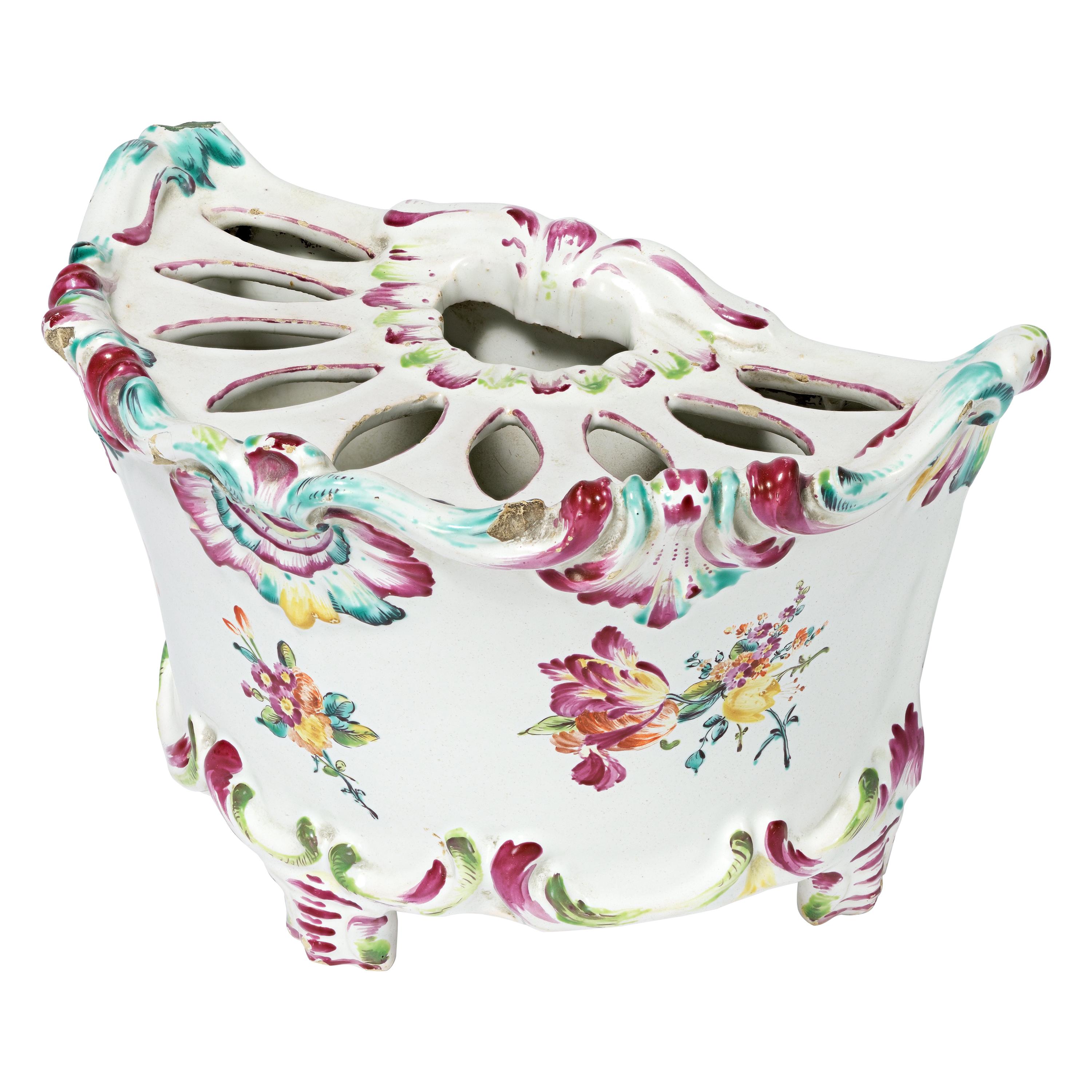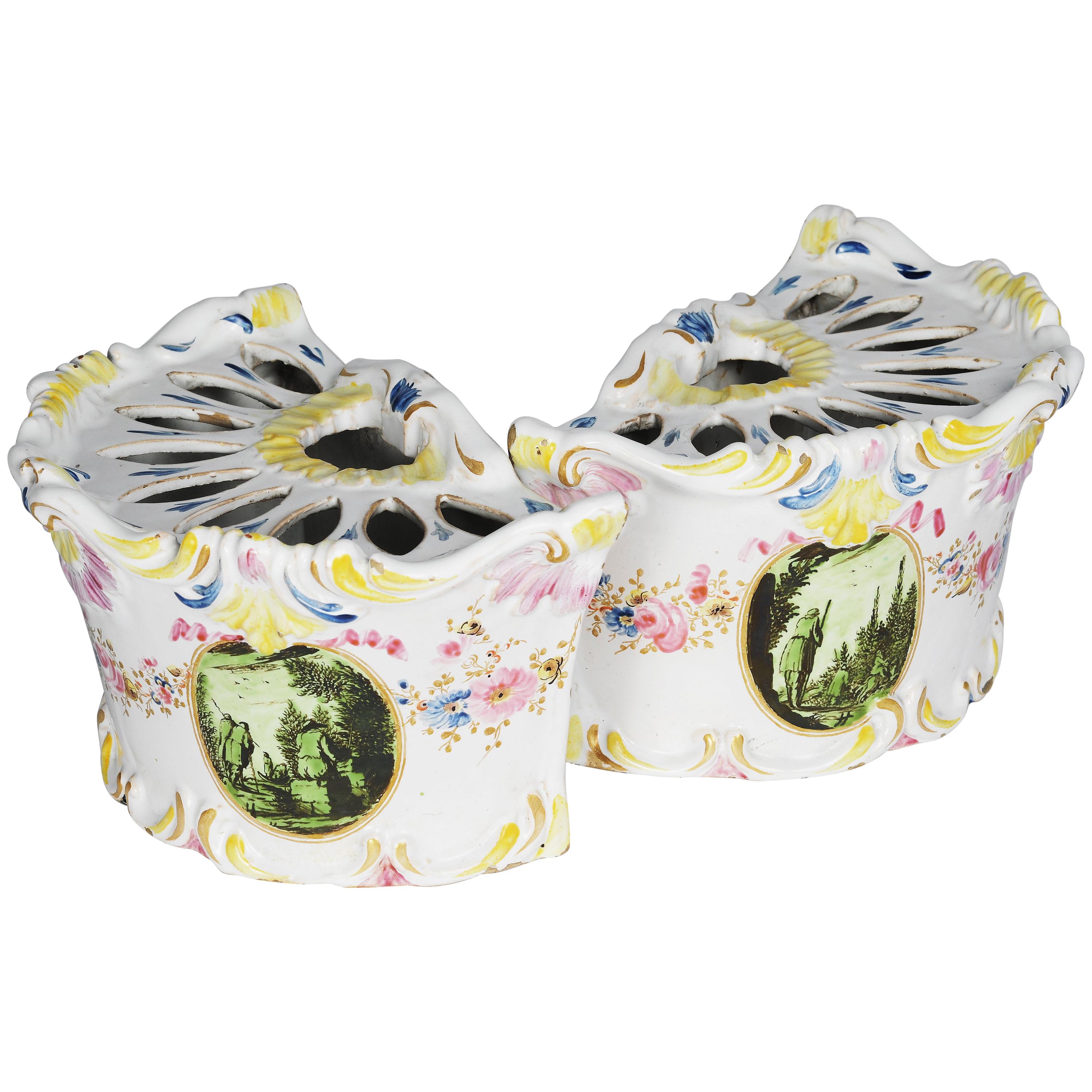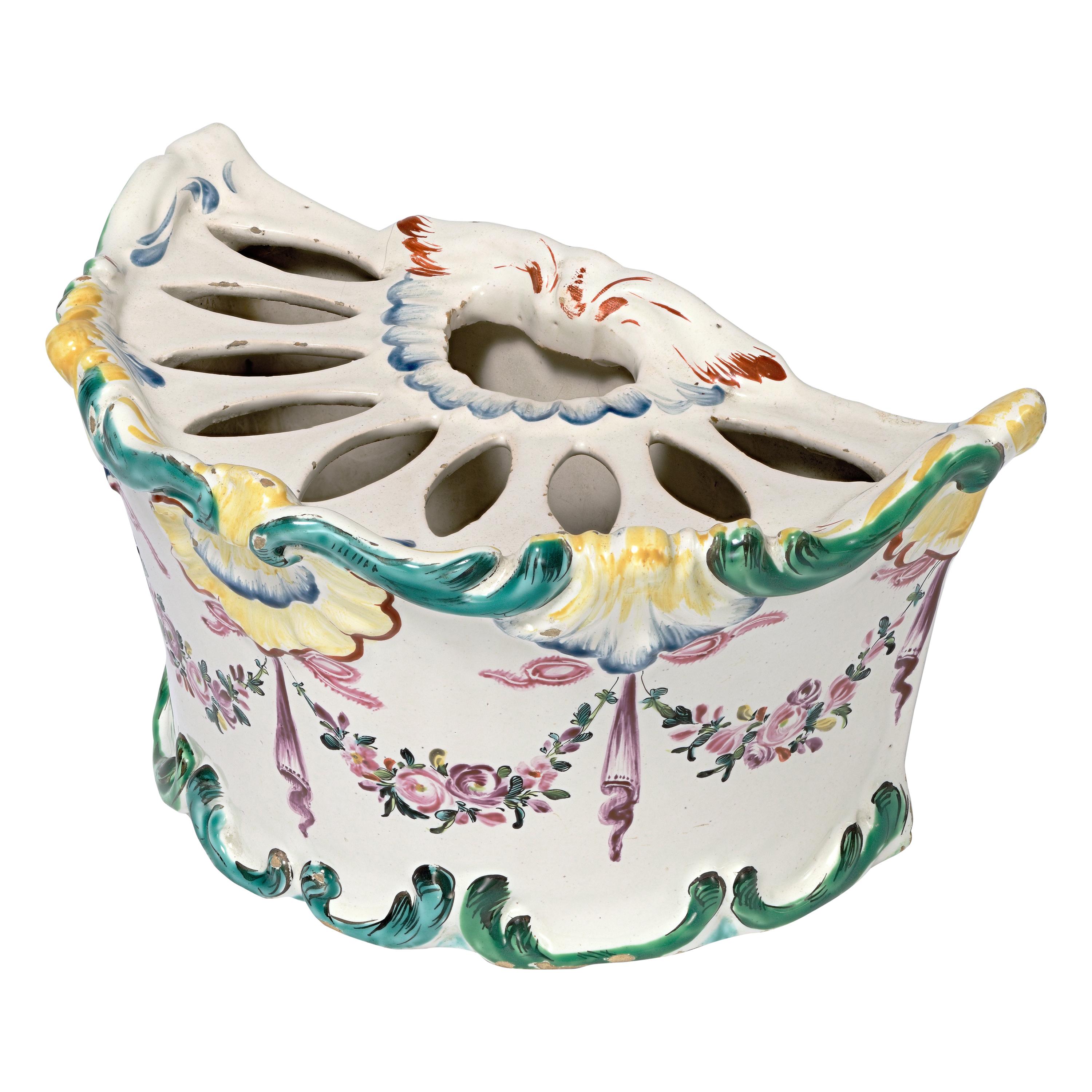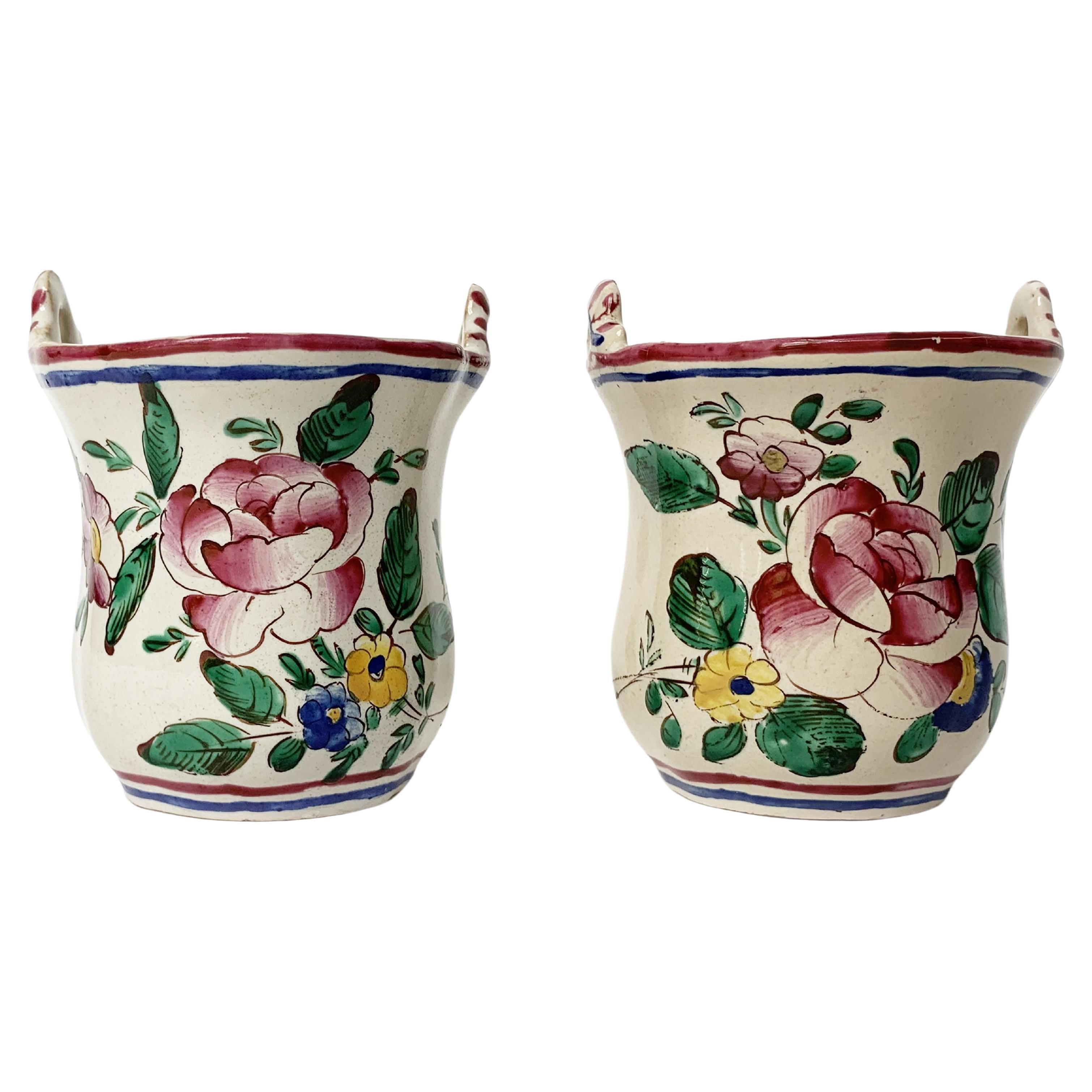Items Similar to 18th Century, Italian Maiolica Flower Pot, Pasquale Rubati, Milan, 1770 circa
Video Loading
Want more images or videos?
Request additional images or videos from the seller
1 of 19
18th Century, Italian Maiolica Flower Pot, Pasquale Rubati, Milan, 1770 circa
About the Item
Maiolica flower pot “a mezzaluna”
decorated with trompe l’oeil
Pasquale Rubati Factory
Milan, 1770 circa
It measures: 4.7 in (cm 12) X 5 in (cm 12.8) X 8.7 in (cm 22.4)
Weight: 1.57 lb (716 g)
State of conservation: intact with slight chipping
A rare example of a flower pot “a mezzaluna” produced by the manufactory of the refined painter Pasquale Rubati, who opened a factory in Milan in 1756 to compete with Felice Clerici.
The flower pot with a complex, as well as original and practical, shape was used to hold flowers while creating an orderly arrangement. As it could also be leant against the wall, its use went beyond simple table centerpieces, but rather it could also be placed in functional and decorative locations.
The maiolica is decorated with a rocaille relief to adorn the edges. The upper part is open to contain the flowers. The mold, indicated in the original inventories as “fioriere a mezzaluna”, was notedly used by the Milanese manufactories of the eighteenth century, as demonstrated by some of the specimens preserved in the Museum of Applied Arts of the Sforzesco Castle in Milan. (See R. Ausenda (edited by), Musei e Gallerie di Milano. Museo d’Arti Applicate. Le ceramiche. Tomo secondo, Milano 2001, p. 425, n. 409 and n. 41; p. 427, n. 414.)
The decoration is in yellow, purple and iron red polychrome. Two medallions painted in purple with figures of wayfarers are joined together by garlands in the shape of a thin, autumnal branch, outlined in iron red.
The polychrome decoration shows two medallions painted in purple with figures of wayfarers, joined together by garlands of minute flowers. The wayfarers and the architectures of the ruin style are placed in a symbolic landscape, painted with brown manganese brushstrokes and shaded with more marked brushstrokes and veiled with the same green background.
The painter freely took the subject of the planters from the engravings of Callot, Della Bella or Piranesi, reinterpreting it with elegance and with great technical expertise. Such meticulousness, comparable to porcelain painting, especially in the resulting small leaves of the garlands, also allows the attribution of the works to the Pasquale Rubati manufactory. A specimen of a flower pot with a brown landscape is kept in the Museum of Villa Cagnola in Varese. Ausenda R. in AA. VV. La collezione Cagnola, II, arazzi, sculture, mobili, ceramiche, Busto Arsizio 1999, p. 196 n. 110.
The theme of the wayfarer and of the pilgrimage is one of the most iconic elements present in eighteenth-century imagery. The taste, generated by the charm of the Arcadian landscape inhabited by shepherds-wandering poets, finds, indeed, wide response precisely in the search for views and emotions that almost always inhabited the expectations of Grand Tour travellers ever since the seventeenth century.
In ceramic production, all this is well evidenced by the success of the almost coeval maiolica of Filippo Comerio in Faenza, whose inventions skilfully sketched in manganese and veiled in emerald green, achieved such a great success at the time, so much so as to change the name of the material from "green Savy" to "green Comerio". (See C. Ravanelli Guidotti, La Fabbrica Ferniani. Ceramiche faentine dal barocco all’ecclettismo, Milano 2009, pp. 259-266.)
As well as its illustrious antecedents with "wayfarers and architectures" produced in Pavia by the painters Africa at Pavese manufactories "Imbres" and "Rampini". (E. Pellizzoni, M. Forni., S. Nepoti, La Maiolica di Pavia tra Seicento e Settecento, Milano 1997)
Or finally, those with "landscapes with ruins and wayfarers" so popular in the shops of Castelli d'Abruzzo. (See, for example, the landscapes of Aurelio Anselmo Grue in F. Filipponi, Aurelio Anselmo Grue, la maiolica del Settecento tra Castelli e Atri, Castelli 2015)
Maiolica and porcelain production in the eighteenth century belonged mainly to the great royal families or in any case to the noble families who made the manufacture of ceramic works a source of prestige. In Milan, under Maria Teresa of Austria, the time period witnessed a real opening to new industrialists who, by virtue of the privatizations granted by the government, assumed a real business risk, giving life, albeit not without conflict, to flourishing factories and to production which was among the most elegant and most requested at the moment and which still today remains object of collection.
Bibliography:
Ausenda R. (a cura di), Musei e Gallerie di Milano. Museo d’Arti Applicate. Le ceramiche. Tomo secondo, Milano 2001, pp. 425, nn. 409 e n. 41; p. 427, n. 414.
Ausenda R. in AA. VV. La collezione Cagnola, II, arazzi, sculture, mobili, ceramiche, Busto Arsizio 1999, p. 196 n. 110.
C. Ravanelli Guidotti, La Fabbrica Ferniani. Ceramiche faentine dal barocco all’ecclettismo, Milano 2009, pp. 259-266.
- Creator:Pasquale Rubati (Manufacturer)
- Dimensions:Height: 4.73 in (12 cm)Width: 8.82 in (22.4 cm)Depth: 5.04 in (12.8 cm)
- Style:Rococo (Of the Period)
- Materials and Techniques:Maiolica,Glazed
- Place of Origin:
- Period:1770-1779
- Date of Manufacture:circa 1770
- Condition:Wear consistent with age and use. Intact with slight chipping.
- Seller Location:Milano, IT
- Reference Number:1stDibs: LU4352229661892
About the Seller
4.3
Vetted Seller
These experienced sellers undergo a comprehensive evaluation by our team of in-house experts.
Established in 1860
1stDibs seller since 2018
19 sales on 1stDibs
Typical response time: 4 hours
Associations
International Confederation of Art and Antique Dealers' Associations
- ShippingRetrieving quote...Ships From: Milano, Italy
- Return PolicyA return for this item may be initiated within 14 days of delivery.
More From This SellerView All
- Ancient Maiolica Flower Pot Pasquale Rubati Factory, Milan Circa 1770By Pasquale RubatiLocated in Milano, ITMaiolica flower pot “a mezzaluna” decorated with tulip Pasquale Rubati Factory Milan, circa 1770. Measures: 4.7 in x 4.7 in x 8.6 in 12 cm x 12...Category
Antique 1770s Italian Rococo Ceramics
MaterialsMaiolica
- Rococo Italian Maiolica Flower Pot Pasquale Rubati, Milano, 1770 circaBy Pasquale RubatiLocated in Milano, ITMaiolica flower pot “a mezzaluna” with support feet decorated with little bunches of flowers Pasquale Rubati Factory Milan, circa 1770 5.5 in X ...Category
Antique 1770s Italian Rococo Ceramics
MaterialsMaiolica
- Pair of Ancient Italian Maiolica Flower Pots Milan, Rubati Factory, 1770 circaBy Pasquale RubatiLocated in Milano, ITMaiolica flower pot “a mezzaluna” decorated with trompe l’oeil Pasquale Rubati Factory Milan, circa 1770 Measures: each 4.7 in (cm 12) x 5 in (c...Category
Antique 1770s Italian Rococo Ceramics
MaterialsMaiolica
- Italian Maiolica Flower Pot Garlands of Flowers, P. Rubati, Milano, 1770 circaBy Pasquale RubatiLocated in Milano, ITMaiolica flower pot “a mezzaluna” decorated with garlands of flowers Pasquale Rubati Factory Milan, circa 1770 Measures: 4.7 in x 5 in x 8.8 in ...Category
Antique 1770s Italian Rococo Ceramics
MaterialsMaiolica
- Antique Italian Maiolica Coolers Pasquale Rubati Manufacture Milan, 1770 CircaBy Pasquale RubatiLocated in Milano, ITAssortment of bottle and glass coolers in Maiolica. Pasquale Rubati manufacture Milan, circa 1770 Maiolica polychrome decorated “a piccolo fuoco” (third fire) a - Bottle cooler 5.91 in x 5.91 in diameter (15 x 15 cm ) Weight: 1.86 lb (845 g) b - Bottle cooler 6.89 x 7.87 in diameter (17,5 x 20 cm) Weight: 2.09 lb (948 g) c - Pair of glass-cooler vases 3.94 x 3.94 in diameter (10 x 10 cm) Weight: 1.43 lb (650 g) Good state of conservation: a - some chipping from use on the edge; a - two fêlures covered on the edge; c - one has deep chippings on the edge and the other a subtle fêlure. Two Majolica factories were active in Milan in the 18th century. The first, starting from 1745, was owned by Felice Clerici; the other one by Pasquale Rubati from 1756. Rubati was in competition with Felice, whose worker he had been prior to opening his own workshop. On his death in 1796, the business was continued for a few more years by his son Carlo. Recent studies have recognized Pasquale Rubati's contribution as the creator of "Strasbourg-style" decorations with their particularly joyful depictions. This style had previously been attributed to the Lodi manufacturers. These works here, however, are a clear example of this production. The Majolica containers have different sizes, a cylindrical shape and rest on a low foot ring. The two largest are completed by handles in the shape of a zoomorphic mask with wide open jaws, while the smaller ones have handles applied with an anthropomorphic mask. All the works are characterized by elegant floral decoration. The two twin glass coolers show bunches of flowers centered around a main corolla, a rose or a peony paired...Category
Antique 1770s Italian Rococo Ceramics
MaterialsMaiolica
- Ancient Maiolica Plates Pasquale Rubati, Milan Circa 1770-1780By Pasquale RubatiLocated in Milano, ITFive oval maiolica dishes with pierced edge Manufacture of Pasquale Rubati Milan, 1770-1780 Three small oval dishes 10.23 in x 7.67 in (26 cm x 19.5 cm) Two large oval dishes 10.82 in x 8.85 in (27.5 x 22.5 cm) lb 3.5 (kg 1.8) State of conservation: intact The five dishes of different sizes have an oval shape, a mixtilinear edge and a molded polylobed shape with a surface enriched with a relief weave motif extending to the brim and forming a perforated basket...Category
Antique 1770s Italian Rococo Ceramics
MaterialsMaiolica
You May Also Like
- Creamware Pair of English Flower Holders, 18th Century circa 1780By Neale & Co.Located in Katonah, NYWHY WE LOVE IT: One of our absolute favorites! A pair of 18th-century creamware flower holders complete with stands and covers made in England by Neale & Co. was one of the finest 18...Category
Antique Late 18th Century English Neoclassical Vases
MaterialsCreamware
- Antique Italian Maiolica Classical Painted Vase 19th CenturyLocated in Bishop's Stortford, HertfordshireA stunning and rare antique Italian Maiolica pottery triple gourd vase hand-painted with classical stylised figurative and scroll designs in typical ...Category
Antique 19th Century Italian Vases
MaterialsMaiolica, Pottery
- Antique Italian Maiolica Portrait Painted Pottery Vase, 19th CenturyLocated in Bishop's Stortford, HertfordshireA stunning and rare antique Italian Maiolica pottery triple gourd vase hand-painted with portraits set amidst classical and scroll designs in typical...Category
Antique 19th Century Italian Vases
MaterialsMaiolica, Pottery
- Pair of Maiolica Polychrome Vases, Italy, 18th CenturyLocated in London, GBA fine pair of Maiolica vases, Painted to one side with a religious figure and to the reverse with a portrait, the sides decorated with traditional large flowers enclosed by yellow s...Category
Antique 18th Century Italian Vases
MaterialsPaint
- Small 18th Century French Rococo Brass Planter Flower PotLocated in Copenhagen, KFrench Rococo Planter or Flower Pot in Brass, Circa 1780 Period French flower pot with beautiful large Rococo decorations.Category
Antique Late 18th Century French Rococo Planters, Cachepots and Jardinières
MaterialsBrass
- 18th Century Italian Yellow Maiolica Pottery Albarello Drug JarLocated in Bradenton, FLAn impressive 18th century polychrome decorated drug jar or 'Albarello'. The Albarello is of a typical waisted shape, and is decorated profusely in polychrome. The body of the jar is...Category
Antique 18th Century Italian Baroque Jars
MaterialsMaiolica, Pottery
Recently Viewed
View AllMore Ways To Browse
All Glass Flowers
Small Glass Flowers
Glass Small Flower
Italian Silver 18th Century
Grand Silver Italy
Red Glass Flower
Glasses With Red Flowers
18th C Glass
Rococo Architecture
L M Silver
18th C Ceramics
Silver Flower Pot
Italian 1770
Flower Pot Glass
Antique Silver Charms
Silver Antique Charms
Antique Charms Silver
Antique Silver Charm





